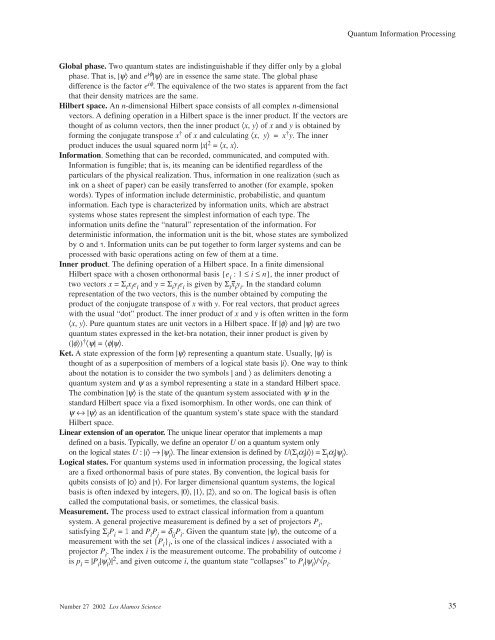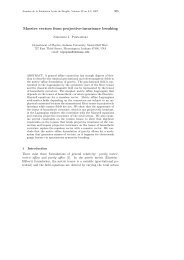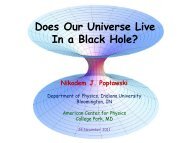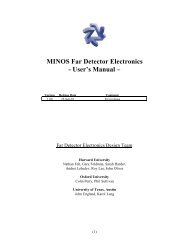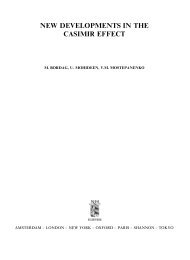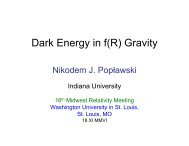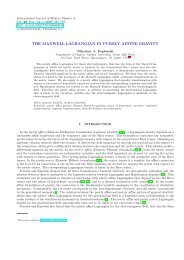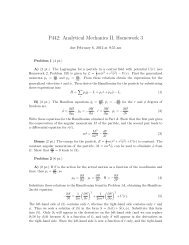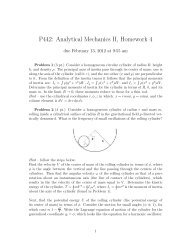Quantum Information Processing
Quantum Information Processing
Quantum Information Processing
Create successful ePaper yourself
Turn your PDF publications into a flip-book with our unique Google optimized e-Paper software.
Global phase. Two quantum states are indistinguishable if they differ only by a global<br />
phase. That is, |ψ〉 and e iφ |ψ〉 are in essence the same state. The global phase<br />
difference is the factor e iφ . The equivalence of the two states is apparent from the fact<br />
that their density matrices are the same.<br />
Hilbert space. An n-dimensional Hilbert space consists of all complex n-dimensional<br />
vectors. A defining operation in a Hilbert space is the inner product. If the vectors are<br />
thought of as column vectors, then the inner product 〈x, y〉 of x and y is obtained by<br />
forming the conjugate transpose x † of x and calculating 〈x, y〉 = x † y. The inner<br />
product induces the usual squared norm |x| 2 = 〈x, x〉.<br />
<strong>Information</strong>. Something that can be recorded, communicated, and computed with.<br />
<strong>Information</strong> is fungible; that is, its meaning can be identified regardless of the<br />
particulars of the physical realization. Thus, information in one realization (such as<br />
ink on a sheet of paper) can be easily transferred to another (for example, spoken<br />
words). Types of information include deterministic, probabilistic, and quantum<br />
information. Each type is characterized by information units, which are abstract<br />
systems whose states represent the simplest information of each type. The<br />
information units define the “natural” representation of the information. For<br />
deterministic information, the information unit is the bit, whose states are symbolized<br />
by and . <strong>Information</strong> units can be put together to form larger systems and can be<br />
processed with basic operations acting on few of them at a time.<br />
Inner product. The defining operation of a Hilbert space. In a finite dimensional<br />
Hilbert space with a chosen orthonormal basis {e i :1 ≤ i ≤ n}, the inner product of<br />
two vectors x = Σ i x i e i and y = Σ i y i e i is given by Σ i x i y i . In the standard column<br />
representation of the two vectors, this is the number obtained by computing the<br />
product of the conjugate transpose of x with y. For real vectors, that product agrees<br />
with the usual “dot” product. The inner product of x and y is often written in the form<br />
〈x, y〉. Pure quantum states are unit vectors in a Hilbert space. If |φ〉 and |ψ〉 are two<br />
quantum states expressed in the ket-bra notation, their inner product is given by<br />
(|φ〉) † 〈ψ| = 〈φ|ψ〉.<br />
Ket. A state expression of the form |ψ〉 representing a quantum state. Usually, |ψ〉 is<br />
thought of as a superposition of members of a logical state basis |i〉. One way to think<br />
about the notation is to consider the two symbols | and 〉 as delimiters denoting a<br />
quantum system and ψ as a symbol representing a state in a standard Hilbert space.<br />
The combination |ψ〉 is the state of the quantum system associated with ψ in the<br />
standard Hilbert space via a fixed isomorphism. In other words, one can think of<br />
ψ ↔|ψ〉 as an identification of the quantum system’s state space with the standard<br />
Hilbert space.<br />
Linear extension of an operator. The unique linear operator that implements a map<br />
defined on a basis. Typically, we define an operator U on a quantum system only<br />
on the logical states U : |i〉→|ψ i 〉. The linear extension is defined by U(Σ i α i |i〉) = Σ i α i |ψ i 〉.<br />
Logical states. For quantum systems used in information processing, the logical states<br />
are a fixed orthonormal basis of pure states. By convention, the logical basis for<br />
qubits consists of |〉 and |〉. For larger dimensional quantum systems, the logical<br />
basis is often indexed by integers, |0〉, |1〉, |2〉, and so on. The logical basis is often<br />
called the computational basis, or sometimes, the classical basis.<br />
Measurement. The process used to extract classical information from a quantum<br />
system. A general projective measurement is defined by a set of projectors P i ,<br />
satisfying Σ i P i = 1 and P i P j = δ ij P i . Given the quantum state |ψ〉, the outcome of a<br />
measurement with the set {P i } i , is one of the classical indices i associated with a<br />
projector P i . The index i is the measurement outcome. The probability of outcome i<br />
is p i = |P i |ψ i 〉| 2 , and given outcome i, the quantum state “collapses” to P i |ψ i 〉/√p i .<br />
<strong>Quantum</strong> <strong>Information</strong> <strong>Processing</strong><br />
Number 27 2002 Los Alamos Science 35


